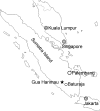Cranio-morphometric and aDNA corroboration of the Austronesian dispersal model in ancient Island Southeast Asia: Support from Gua Harimau, Indonesia
- PMID: 29933384
- PMCID: PMC6014653
- DOI: 10.1371/journal.pone.0198689
Cranio-morphometric and aDNA corroboration of the Austronesian dispersal model in ancient Island Southeast Asia: Support from Gua Harimau, Indonesia
Abstract
The Austronesian language is spread from Madagascar in the west, Island Southeast Asia (ISEA) in the east (e.g. the Philippines and Indonesian archipelagoes) and throughout the Pacific, as far east as Easter Island. While it seems clear that the remote ancestors of Austronesian speakers originated in Southern China, and migrated to Taiwan with the development of rice farming by c. 5500 BP and onto the northern Philippines by c. 4000 BP (the Austronesian Dispersal Hypothesis or ADH), we know very little about the origins and emergence of Austronesian speakers in the Indonesian Archipelago. Using a combination of cranial morphometric and ancient mtDNA analyses on a new dataset from Gua Hairmau, that spans the pre-Neolithic through to Metal Period (5712-5591cal BP to 1864-1719 cal BP), we rigorously test the validity of the ADH in ISEA. A morphometric analysis of 23 adult male crania, using 16 of Martin's standard measurements, was carried out with results compared to an East and Southeast Asian dataset of 30 sample populations spanning the Late Pleistocene through to Metal Period, in addition to 39 modern samples from East and Southeast Asia, near Oceania and Australia. Further, 20 samples were analyzed for ancient mtDNA and assigned to identified haplogroups. We demonstrate that the archaeological human remains from Gua Harimau cave, Sumatra, Indonesia provide clear evidence for at least two (cranio-morphometrically defined) and perhaps even three (in the context of the ancient mtDNA results) distinct populations from two separate time periods. The results of these analyses provide substantive support for the ADH model in explaining the origins and population history of ISEA peoples.
Conflict of interest statement
The authors have declared that no competing interests exist.
Figures




Similar articles
-
Genetic insights into the origin, admixture, and migration of the early Austronesian peoples.J Hum Genet. 2025 Aug 7. doi: 10.1038/s10038-025-01380-8. Online ahead of print. J Hum Genet. 2025. PMID: 40775104 Review.
-
Balinese Y-chromosome perspective on the peopling of Indonesia: genetic contributions from pre-neolithic hunter-gatherers, Austronesian farmers, and Indian traders.Hum Biol. 2005 Feb;77(1):93-114. doi: 10.1353/hub.2005.0030. Hum Biol. 2005. PMID: 16114819
-
Tracing the Austronesian footprint in Mainland Southeast Asia: a perspective from mitochondrial DNA.Mol Biol Evol. 2010 Oct;27(10):2417-30. doi: 10.1093/molbev/msq131. Epub 2010 May 31. Mol Biol Evol. 2010. PMID: 20513740
-
The first quantitative assessment of radiocarbon chronologies for initial pottery in Island Southeast Asia supports multi-directional Neolithic dispersal.PLoS One. 2021 Jun 2;16(6):e0251407. doi: 10.1371/journal.pone.0251407. eCollection 2021. PLoS One. 2021. PMID: 34077445 Free PMC article.
-
Ancient migration routes of Austronesian-speaking populations in oceanic Southeast Asia and Melanesia might mimic the spread of nasopharyngeal carcinoma.Chin J Cancer. 2011 Feb;30(2):96-105. doi: 10.5732/cjc.010.10589. Chin J Cancer. 2011. PMID: 21272441 Free PMC article. Review.
Cited by
-
Craniometrics Reveal "Two Layers" of Prehistoric Human Dispersal in Eastern Eurasia.Sci Rep. 2019 Feb 5;9(1):1451. doi: 10.1038/s41598-018-35426-z. Sci Rep. 2019. PMID: 30723215 Free PMC article.
-
[Skull-facial anthropometric traits of forensic odontological interest for estimating sex, race and age. Review of the literature].Rev Cient Odontol (Lima). 2021 Mar 11;9(1):e047. doi: 10.21142/2523-2754-0901-2021-047. eCollection 2021 Jan-Mar. Rev Cient Odontol (Lima). 2021. PMID: 38464411 Free PMC article. Review. Spanish.
References
-
- Bellwood P. Prehistory of the Indo-Malaysian Archipelago. 3rd ed Honolulu, Hawaii: University of Hawai'i Press; 2007.
-
- Blust R. Austronesian culture history: The window of language. TAPS. 1996;86(5):28–35. doi: 10.2307/1006619 - DOI
-
- Blust R. Beyond the Austronesian homeland: The Austric hypothesis and its implications for archaeology. TAPS. 1996;86(5):117–58. doi: 10.2307/1006623 - DOI
-
- Bellwood P. The origins and dispersals of agricultural communities in Southeast Asia In: Glover I, Bellwood PS, editors. Southeast Asia: From prehistory to history. New York: RoutledgeCurzon; 2004. p. 21–40.
-
- Bellwood P. Examining the farming/language dispersal hypothesis in the East Asian context In: Blench R, Sagart L, Sanchez-Mazas A, editors. The peopling of East Asia: Putting together archaeology, linguistics and genetics. London: RoutledgeCurzon; 2005. p. 17–30.
Publication types
MeSH terms
Substances
LinkOut - more resources
Full Text Sources
Other Literature Sources

